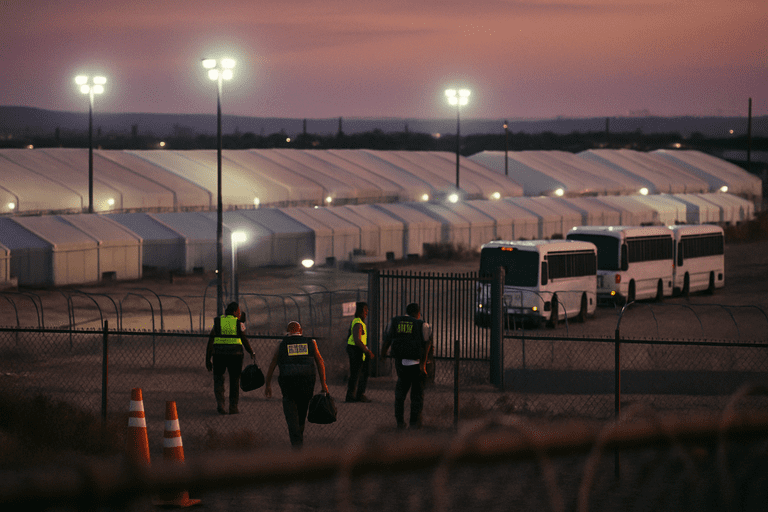🎧 Listen to the summary:
The administration’s deportation plan is unapologetically bold: a concentrated, well‑resourced campaign that restores federal presence, accelerates enforcement, and signals that longstanding immigration laws will be implemented with speed and scale. Backed by a major funding infusion, clear daily arrest goals, and cross‑agency task forces, the effort equips ICE, CBP and partner agencies with the muscle to detain more people, move cases quickly, and prioritize genuine public‑safety threats. Where previous years saw diffuse guidance and halting enforcement, this program places unmistakable command authority at the center of operations — an unmistakable demonstration that the state can act decisively when it chooses to do so.
Those deciding to act did so through a suite of executive orders in January 2025 that formally declared a national emergency, described large‑scale migration in the most urgent terms, and authorized military support for DHS operations. The orders rescind earlier limits on enforcement in sensitive locations such as schools and churches, push expedited removal to the maximum extent Congress allows, and direct DHS to build and operate new detention capacity. They also create incentives for voluntary departures, impose civil fines, and demand agencies staff up to meet far faster removal timelines. The paperwork and legal architecture are blunt instruments by design: they sacrifice procedural slowness for operational tempo, because the point is to move.
Implementation rides on three levers — money, manpower, and detention space — and Congress supplied a financing package of historic size to match the ambition. Reporting details roughly $170 billion set aside for enforcement and border security, including about $75 billion for ICE and roughly $45 billion aimed at expanding detention capacity toward more than 100,000 beds. The package contemplates hiring up to 10,000 additional deportation officers and modernizing the transport fleet that moves detainees from arrest to courtrooms and onto removal flights. Those figures are not ornamental; they are the material infrastructure of a campaign that intends to be continuous rather than episodic.
Manpower has been broadened aggressively. Federal details and state‑local partnerships expand the pool of officers available for interior operations: Border Patrol personnel have been pressed into assistive roles for arrests normally handled by ICE’s Enforcement and Removal Operations, and multijurisdictional taskings combine federal, state and local assets. At the leadership level, the return of Tom Homan as a senior coordinator brought explicit emphasis on workplace enforcement, logistics, and the mechanics of moving people out of the country — the kind of managerial focus that turns strategy into daily output.
Local cooperation has been scaled through renewed 287(g) agreements and a revived task‑force model that deputizes local officers to make immigration arrests during routine policing. By late June 2025 there were some 360 task‑force style agreements across 29 states, with Florida the largest single host, and broader 287(g) partnerships exceeded 700 agencies within five months. Even state troopers in some jurisdictions have been deputized under separate federal authorities. The effect is a wider federal footprint made possible by local boots on the ground — a trade‑off, to be sure, but one that multiplies reach.
Detention infrastructure has been retooled at pace. Tent facilities originally built for short‑term border processing were repurposed to hold ICE detainees in El Paso, with part of the setup funded by the Department of Defense under the emergency declaration. Contract records point to potential multibillion‑dollar awards to operate a migrant detention site at Fort Bliss, alongside smaller contracts for the El Paso site and for unarmed guards. Officials have even explored military facilities for housing, and some detainees have been held at Guantánamo Bay — stark choices that make clear the administration’s willingness to use every available asset to sustain removals.
Operational tempo rose quickly. Nationwide coordinated actions produced 956 arrests on a single Sunday in late January, then climbed to about 1,300 by Thursday as multiagency teams spread through major metropolitan areas. Internal targets that later surfaced — a reported aim of 3,000 arrests per day — illustrate the administration’s intent to convert episodic raids into steady throughput. Those numbers are evidence of capacity: when personnel, transport and detention align, removals accelerate dramatically.
That acceleration brings explicit trade‑offs, and the administration has not pretended otherwise. Expanding expedited removal compresses case timelines by allowing deportations without full immigration‑court proceedings for people who cannot quickly prove two years of U.S. presence. The benefit is a reduced litigation backlog and faster resolution; the cost is an increased risk of errors when identities and documents are difficult to retrieve on an accelerated timetable. Courts have already enjoined or narrowed pieces of the fast‑track regime, producing patchwork limits that add friction to field operations. Those legal setbacks are not mere political rebukes — they are the predictable pushback that comes when a government pushes institutional boundaries.
Rapid scaling also generates operational pinch points. Reporting documented a jump in non‑criminal detainees from roughly 860 to about 11,800 between January and mid‑June 2025, and DHS paused some public reporting during that period — a combination that complicates outside verification and underscores the strain of moving so fast. Transportation and medical contracting have been stretched; attorney access in remote facilities is harder to guarantee; and standards designed for short border holds have been stressed by extended interior detention, with family separation and the need to keep adults and children apart creating agonizing procedural demands. These are concrete, measurable costs — not abstractions — and they stand as proof of the administration’s seriousness: large programs break systems; only by acknowledging and absorbing those breaks can a program be sustained.
Deputization and task forces expand reach but diffuse accountability, another unavoidable consequence. Civil‑rights groups and researchers warn that task force‑style 287(g) policing raises the risk of racial profiling, erodes trust in immigrant communities, and diverts local budgets toward federal priorities. Reports of wrongful detentions, including of U.S. citizens, have emerged amid rapid operations. These errors are operational hazards rather than ideology — the messy fallout of moving vast numbers of people through sped‑up processes. The administration’s posture appears to be that willingness to accept these hard consequences is itself evidence of resolve: a serious policy demands toleration of some collateral strain.
Mechanics continue to evolve. Officials have set daily arrest targets, built integrated task forces, and secured long‑horizon funding to keep planes and beds available even as court dockets fill. Early raids show how quickly the arithmetic of enforcement changes when staffing, transport and detention are aligned; procurement and fieldwork have run in parallel, with inefficiencies cropping up whenever legal limits, staffing, or local coordination lag behind operational intent.
The immediate battlegrounds are now courts and appropriators. Federal judges have issued temporary restraints on parts of the playbook, and lawsuits over expedited removal, deputization, and sensitive‑location arrests are pending. Appropriations oversight will determine future bed counts, flight capacity, and hiring. For now, daily arrest goals, expanded 287(g) partnerships, and newly funded transport and detention assets define how far and how fast the campaign will go. The administration has chosen clarity of purpose and the willingness to pay real costs — financial, legal, and human — as the price of restoring what it casts as order and the rule of law. Those costs are not accidental; they are the hard evidence that a government is acting with determination rather than acquiescence.
—
Lisa Grant reports on immigration enforcement, border operations, and national security protocols. She studied political science at Arizona State University and previously worked as a legislative staffer on immigration reform. Her reporting brings a field-level understanding of border policy and how it is applied in communities across the Southwest.



